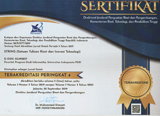Implementasi Komparasi Algoritma Klasifikasi Menentukan Kelulusan Mata Kuliah Algoritma Universitas Budi Luhur
(1)
(*) Corresponding Author
Abstract
Keywords
Full Text:
PDFReferences
Bramer, M.(2007). Principles of Data Mining London: Springer Clark. L.A., Kochanska, G., & Ready, R. (2000). Mothers' personality and its interaction with child temperament as predictors of parenting behavior. Journal of Personality and Social Psychology, 79, 274-285.
Fawcett, T. (2006). An introduction to ROC analysis. Pattern Recognition Letters, 27(8), 861–874.
Gorunescu, F. (2011). Data Mining: Concepts, Models and Techniques. Berlin: Springer.
Jang, J. S., Sun, C. T., dan Mizutani, E. (1997). Neuro-Fuzzy and Soft Computing : A Computational Approach to Learning and Machine Intelligence. New Jersey: Prentice Hall.
Khan, I. A., dan Choi, J. T. (2014). An Application of Educational Data Mining (EDM) Technique for Scholarship Prediction. International Journal of Software Engineering and Its Applications, 8(12), 31-42.
Vercellis, C. (2009). Business Intelligence. United John Wiley and Sons.
DOI: http://dx.doi.org/10.30998/string.v3i1.2334
Refbacks
- There are currently no refbacks.
Copyright (c) 2018 STRING (Satuan Tulisan Riset dan Inovasi Teknologi)

This work is licensed under a Creative Commons Attribution 4.0 International License.
STRING (Satuan Tulisan Riset dan Inovasi Teknologi) indexed by:

Ciptaan disebarluaskan di bawah Lisensi Creative Commons Atribusi 4.0 Internasional.
View My Stats


 Sertifikat Akreditasi
Sertifikat Akreditasi
















